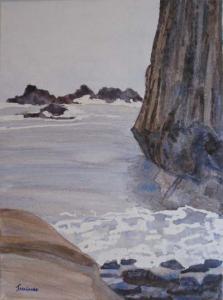
I took the working photos for this one on a cold wet winter day on Seal Rock Beach just south of Newport, Oregon. At low tide it's a fantastic place for poking in tide pools. At high tide it's a wave watcher's heaven.
This is the fourth watercolor I've done on canvas. Watercolor is a whole different animal on canvas. It even sounds different, like painting on a drum.
Canvas is just a hair smoother than cold-pressed paper, but the texture is very different. Cotton has a grain whereas paper does not. Greater detail is possible on cotton than on cold-pressed paper. But that's just the beginning.
Canvas absorbs more water, so it takes much longer to dry; and drying is crucial because unless a wash is bone dry it will lift from canvas in a heart beat. In fact it's extremely easy to lift watercolor from canvas. All but the most staining pigments will wipe back to white with one swipe of the sponge. It's great for correcting mistakes but lifting just a little color for highlight is next to impossible. Mask will also lift paint back to white making it easy to add white details.
On the other hand, canvas accepts much thicker darker paint without getting muddy and dead looking. I'm coming to the conclusion that this last is the primary advantage of canvas for me. And that is why I painted this particular painting on canvas. I wanted to make the dark rocks just as dark and cold as they really were without worrying about dead chalky looking paint.
Since it is framed without glass the last step in a watercolor on canvas is to spray it with a clear protective finish. I use a matte finish. I don't want shine.
(Excerpt from my blog as jennyarmitage.com/blog)